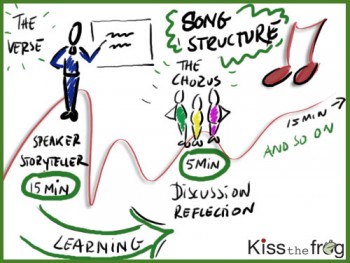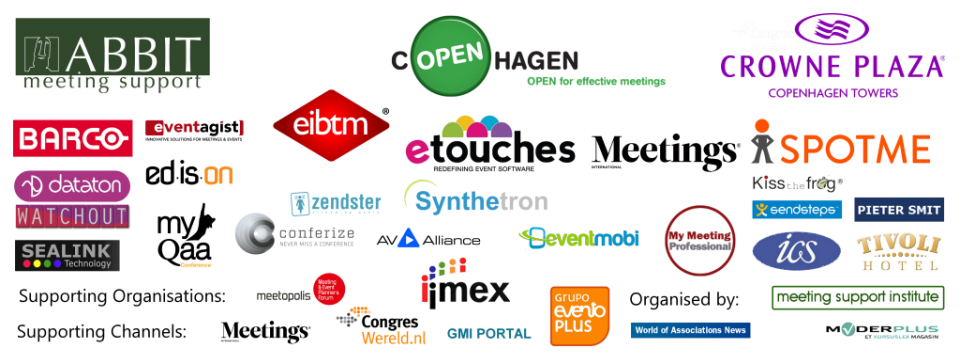FRESH13 is about new insights into meeting design and we want to demonstrate that to you in the most practical way possible. So, in the period before FRESH13 we will be sharing with you some of our own experiences, comments and thoughts in the form of FRESH Newsletters we will be mailing out on a regular basis.
If you are not already on our mailing list, use the 'Get FRESH News' button on the home page to sign up.
If you are looking for many more ideas like these, you should register for FRESH13 now? Join us in Copenhagen - you will discover a world of great meeting ideas and a whole bunch of new colleagues and new friends eager to trade experiences with you now and in the future.
What can songs teach us about presentations?
By Maarten Vanneste; President, Meeting Support Institute
 Popular songs catch and keep your attention Verse - chorus - verse - chorus - verse Listen to the radio and you will see for yourself: this is the structure of the typical songs we hear every day. And I suggest we can ‘take that’ as the framework we should embed in our presentations too. “ Verse-Chorus: a musical form common in popular music where the chorus is highlighted.“ (Wikipedia) In the verse the singer plays the main role; the lyrics dominate and the story flows and develops. In the chorus we hear more instruments, more background singers or choir, more volume and changed rhythms. The song goes up and down in waves of variation and emotion: verse to chorus to verse... The chorus engages our attention, excites us and provides us an opportunity to join in and sing along. All popular songs are produced like this because otherwise we, the listeners, would get bored. Since boring songs don’t sell, the less-successful monotonic gene died out: simple evolution. The same structure works for presentations too Monotony is one of the major challenges in formal presentations. People are easily-enough distracted anyway, but one long verse - in this case, one long speech - with limited variation just makes us lose attention. And presentations are often one such long verse; maybe not a totally boring and monotonous verse, but still. Limited variation doesn’t lead to successful presentations. |
It is time to adopt the song structure and give presentation a set of emotional waves, pitching it with a minimum of: verse-chorus-verse-chorus-verse.
Verse: Of-course, a presentation needs verse during which the speaker is centre stage and displays his expertise. It is the heart of many meetings and conferences. One person speaks, shows pictures, explains and talks while the audience listens. The focus is on the speaker, the words he speaks are of utmost importance: they are the essence. Verses in presentations can and should be longer than the choruses. But choruses should be welcomed as the necessary variation to allow the audience to engage and participate. Chorus: So, what is the chorus in a presentation? Simple: it is when you give time to the audience and let them discuss in small groups what they just heard. Give them a question to talk about, or a statement. Immediately, the atmosphere in the room changes: many more voices speak; the soundscape changes; bodies move; the energy shifts ... Now the participants have switched from a listening mode to an active discussion mode, using different parts of their brains, increasing blood supply and changing the levels of several hormones. The mental variation is also physical – as listening becomes learning. Harness the power of Chorus Each chorus is a break; it gets the audience ready for the next verse, enabling them to listen further without getting distracted or bored. The chorus also is the best way to make participants remember the verse. Discussing, contextualising, putting things in perspective, merging the information into their own world, all this leads to better learning. Every speaker should always use at least two choruses - as in the shortest songs - creating two breaks of a few minutes, structuring the one long presentation into three digestible verses, alternating with the choruses. Every presentation should include two slides with a relevant discussion item - a question or a statement – always. These two slides are a clear sign to the speaker to hand over to the group and start the discussion. It also reminds speakers of where they are: at one third or at two thirds of the presentation. The chorus will usually be shorter than a verse: a 3-1-3-1-3 ratio is fine; 15 minutes of presentation followed by 5 minutes of discussion. This cadence can be varied depending on the audience and the purpose of the presentation - it could easily be 5-1-5-1-3 or 2-1-2-1-2-1-2-1, etc. Speakers can create own song structure, but must be sure to have one. |
How will you use the power of Chorus in your next meeting?
Can you test this in your own presentation?
Can you do this in your meetings or conference?
Can you make your speakers do it?
Feel free to use this “song structure” metaphor to convince speakers; everyone can relate to something as common as a pop song ... It is worth it; your conference, meeting or presentation will be much more fun and much more effective because of it.



